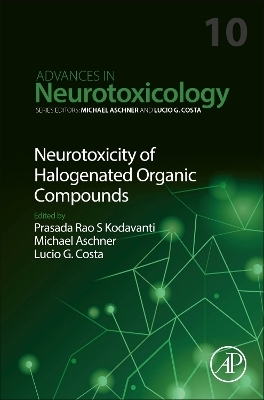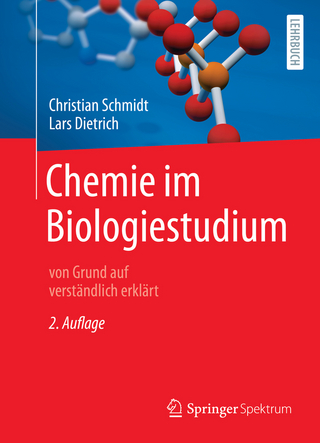
Neurotoxicity of Halogenated Organic Compounds
Academic Press Inc (Verlag)
978-0-443-13340-4 (ISBN)
Other chapters cover Neuroendocrine Effects of Brominated Flame Retardants (BFRs), Focused on Polybrominated Diphenyl Ethers (PBDEs), Neurochemical Effects of Halogenated Organic Compounds: Possible Mode(s) of action and Structure-Activity Relationships, The Neurotoxic Effects of Perfluoroalkyl Substances (PFAS) in Animal Models and Human Cohorts, Neurochemical Mechanisms of Perfluoroalkyl Substances (PFAS) Neurotoxic Action, and Future Directions and Regulatory aspects of Halogenated Organic Compounds.
Dr. Lucio G. Costa is Professor of Toxicology at the University of Washington in Seattle, and of Pharmacology/Toxicology at the University of Parma Medical School. He received a doctorate in Pharmacology from the University of Milano in 1977, and was a postdoctoral fellow at the University of Texas at Houston. He is a member of several national and international professional organizations, a Fellow of the Academy of Toxicological Sciences, and a European Certified Toxicologist. He received various award for his scientific accomplishments, including the Achievement Award from the Society of Toxicology. He serves in various editorial capacities for several toxicology journals, and is an active manuscript and grant reviewer. Dr. Costa has been the member of dozens of panels and committees at the national and international level dealing with toxicology and risk assessment issues. He has chaired and/or organized symposia at scientific meetings in the United States and internationally. He has been teaching classes in the area of toxicology, neurotoxicology and pharmacology to graduate and medical students for 30 years. He keeps an active research program in the area of neurotoxicology. Dr. Aschner serves as the Harold and Muriel Block Chair in Molecular Pharmacology at Albert Einstein College of Medicine. He served on numerous toxicology panels (Institute of Medicine, US Environmental Protection Agency, Center for Disease Control), and is a member of the Neurotoxicology and Alcohol study section (NIH). Research in our lab focuses on the following topics: (1) Modulation of C. elegans genes (aat, skn-1, daf-16) that are homologous to mammalian regulators of MeHg uptake and cellular resistance will modify dopaminergic neurodegeneration in response to MeHg exposure. (2) Under conditions of MeHg-induced oxidative stress, Nrf2 (a master regulator of antioxidant responses) coordinates the upregulation of cytoprotective genes that combat MeHg-induced oxidative injury, and that genetic and biochemical changes that negatively impact upon Nrf2 function increase MeHg’s neurotoxicity. (3) PARK2, a strong PD genetic risk factor, alters neuronal vulnerability to modifiers of cellular Mn status, particularly at the level of mitochondrial dysfunction and oxidative stress. Our studies are designed to (1) shed novel mechanistic insight into metal-induced neurodegeneration; (2) identify targets for genetic or pharmacologic modulation of neurodegenerative disorders; (3) increase knowledge of the pathway involved in oxidative stress; (4) develop improved research models for human disease using knowledge of environmental sciences. Dr. Prasada Kodavanti is a Senior Research Toxicologist at the Neurological & Endocrine toxicology branch of Public Health & Integrated Toxicology Division at CPHEA/ORD, U.S. Environmental Protection Agency in Research Triangle Park, NC, USA. In this role, he leads a team of scientists to develop in vitro models based on adverse outcome pathways (AOPs) and O’mics technology in New Approach Methods (NAMs) by selecting a few chemicals for initial testing. The goal is to develop efficient NAMs based on O’mics for screening and prioritization of untested chemicals and also provide scientific support for the existing NAMs such as neurite outgrowth and microelectrode array assays. He also plays a key role in the Safe and Healthy Communities project related to understanding the interaction between chemical stressors and non-chemical factors and develop genomic biomarkers in blood to identify vulnerable communities. He joined the USEPA as a Toxicologist in January of 1995. Dr. Kodavanti is a recognized scientist internationally in the area of halogenated organic compounds and adult/developmental neurotoxicity. Dr. Kodavanti is an extremely prolific researcher with over 125 peer-reviewed journal articles. In addition, he is primary author on 26 book chapters as well as 8 review articles. His publications appear in a wide variety of leading scientific journals and is well quoted by scientists in this field. In 1996, one of his papers won the prestigious Society of Toxicology’s Board of Publications Award for the Best Paper in Toxicology and Applied Pharmacology. He received USEPA’s 1996, 1999, 2002, and 2012 Scientific and Technological Achievement (STAA) Award. In 2009, he received STAA level 1 award (highest scientific award by USEPA) for highlighting genomics in understanding mode of action in developmental neurotoxicity. Dr. Kodavanti gave several invited presentations at national and international meetings. Dr. Kodavanti served as session chair in several conferences and a member of Special session organizing committee of the Dioxin ’97. He is a member of the Advisory Board for several journals and current ones include “The Open Toxicology and “Neurotoxicology. He was an Associate Editor for the journal “Drug and Chemical Toxicology. Dr. Kodavanti is also an Adjunct Professor of Toxicology, School of Pharmacy at University of Rhode Island, Kingston, RI since April 2000. He is also a reviewer for a number of International scientific journals.
Preface
Prasada Rao S. Kodavanti, Michael Aschner and Lucio G. Costa
1. Perspective on Halogenated Organic Compounds
Prasada Rao S. Kodavanti
2. The Neurotoxicity of Polychlorinated Biphenyls (PCBs)
Pamela J. Lein
3. Neuroendocrine Effects of Polychlorinated Biphenyls (PCBs)
Margarita Curras-Collazo, Andrea C. Gore and Thomas Zoeller
4. Mechanisms of PCB Neurotoxicity: AHR and THR Dogma meet RYR reality
Isaac Ness Pessah
5. Microbiome and the Neurotoxicity of Brominated Flame Retardants (BFRs)
Lucio G. Costa
6. Neuroendocrine Effects of Brominated Flame Retardants (BFRs), Focused on Polybrominated Diphenyl Ethers (PBDEs)
Martha León-Olea
7. Neurochemical Effects of Halogenated Organic Compounds: Possible Mode(s) of action and Structure-Activity Relationships
Prasada Rao S. Kodavanti
8. The Neurotoxic Effects of Perfluoroalkyl Substances (PFAS) in Animal Models and Human Cohorts
Katie O’Shaughnessy
9. Neurochemical Mechanisms of Perfluoroalkyl Substances (PFAS) Neurotoxic Action
Jason R. Cannon
10. Future Directions and Regulatory aspect of Halogenated Organic Compounds
Geniece M. Lehman
| Erscheinungsdatum | 24.10.2023 |
|---|---|
| Reihe/Serie | Advances in Neurotoxicology |
| Verlagsort | San Diego |
| Sprache | englisch |
| Maße | 152 x 229 mm |
| Gewicht | 450 g |
| Themenwelt | Naturwissenschaften ► Biologie ► Biochemie |
| Naturwissenschaften ► Biologie ► Humanbiologie | |
| Naturwissenschaften ► Biologie ► Zoologie | |
| ISBN-10 | 0-443-13340-9 / 0443133409 |
| ISBN-13 | 978-0-443-13340-4 / 9780443133404 |
| Zustand | Neuware |
| Informationen gemäß Produktsicherheitsverordnung (GPSR) | |
| Haben Sie eine Frage zum Produkt? |
aus dem Bereich


